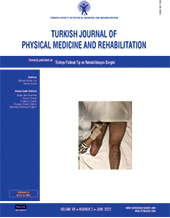Therapeutic effect of gait training with two types of ankle-foot orthoses on the gait of the stroke patients in the recovery phase
2 International University of Health & Welfare, Tokyo, Japan
3 Nakaizu Rehabilitation Center, Izu, Japan
4 Nerima Kenikukai Hospital, Tokyo, Japan DOI : 10.5606/tftrd.2022.7866 Objectives: This study aimed to demonstrate the therapeutic effect of gait training using ankle-foot orthoses (AFOs) on the gait of stroke patients when not wearing AFOs with two different types of AFO, an AFO with an oil damper (AFO-OD) that resists plantarflexion and an AFO with a plantarflexion stop (AFO-PS), and to display the possible differences between the AFO types.
Patients and methods: Forty-two patients (38 males, 4 males, mean age: 59.7±10.9; range, 38 to 81 years) with subacute stroke were randomized to either an AFO-PS or an AFO-OD group. Participants were given gait training in a two-week period by physiotherapists wearing their allocated AFO. Nineteen patients were assigned to the AFO-PS group and 20 to the AFO-OD group. Patients' gait without an AFO before gait training and then after two weeks of training wearing allocated AFOs was recorded through a three-dimensional movement capture system.
Results: A therapeutic effect through two weeks of continuous use of AFOs and gait training was found in both AFO groups (main effect of time) in the spatiotemporal factors, ankle joint moments, ankle power generation, shank-to-vertical angle, and center of gravity velocity throughout the stance phase, pre-swing knee angular velocity, and hip flexion moment in pre-swing. The results did not show a large interaction between two AFOs group.
Conclusion: These findings reveal that both AFOs had significant therapeutic effects on stroke gait. There was no significant difference between the two AFO groups. Further studies with a control group representing the effects of gait training without wearing an AFO are needed.
Keywords : Ankle-foot orthosis, gait, orthotic, stroke, therapeutic effect, training

















